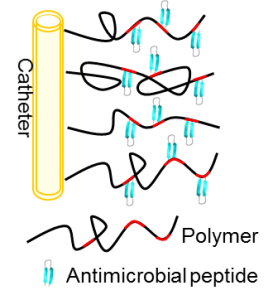 By Prashant Kumar, PhD Candidate, Kizhakkedathu Lab, CBR
By Prashant Kumar, PhD Candidate, Kizhakkedathu Lab, CBR
Catheter-associated urinary tract infections (CAUTIs) are common and lead to increased patient morbidity and mortality, prolonged hospital stays, with resulting elevated health care costs. In spite of there being a reduction in CAUTIs with strict adherence to aseptic techniques during catheter insertion, the incidence of infection remains high. Antibiotic treatment may be effective, but bacterial resistance inevitably develops, and the infection may become widespread, placing the patient at high risk.
CAUTIs begin with pathogens attaching to the catheter surface. They then multiply to develop into so-called “biofilms”, which are particularly resistant to antibiotic treatment. To address this problem, Centre for Blood Research (CBR) investigators Drs. Kizhakkedathu, Brooks and Hancock collaborated with Dr. Lange from the Department of Urological Sciences, to design a novel polymer-based antimicrobial peptide (AMP) catheter to prevent CAUTIs. Their unique invention was published in the journal Biomaterials.
Dr. Kai Yu, the lead author of the paper, commented, “We developed a novel coating design strategy for the catheter surface by combining an anti-adhesive polymer with an antimicrobial peptide to arrive at broad spectrum antimicrobial activity”
The new layer on the catheter has a dual purpose; 1) the anti-adhesive polymers prevent bacteria from attaching to the catheter surface, and 2) the AMP increases the effectiveness of bacterial killing that occurs within the device.
Interestingly, in mouse models, the AMP-coated polyurethane catheters were able to prevent infection with high efficiency by reducing the amount of bacteria attaching to the catheter surface by almost 100,000-fold compared to the uncoated catheter surface. The coated catheters also decreased bacterial growth in the urine by nearly 1,000-fold in 7 days.
This is the best performance for a device coating reported so far for preventing CAUTI and it was effective against both Gram-positive and Gram-negative bacteria. The new catheters also had excellent biocompatibility in mice and did not cause any negative local or systemic immune responses.
Dr. Yu shared, “The next step is to simplify the synthesis procedure and to develop an easy way to coat the urinary catheter to make it infection resistant. Then the technology can be expanded to other medical devices such as ureteral stents and other catheters”. This will help advance this new and exciting technology towards commercialization and clinical evaluation.
This research was funded by grants from the Canadian Institutes of Health Research (CIHR) and Natural Science and Engineering Research Council of Canada (NSERC).



